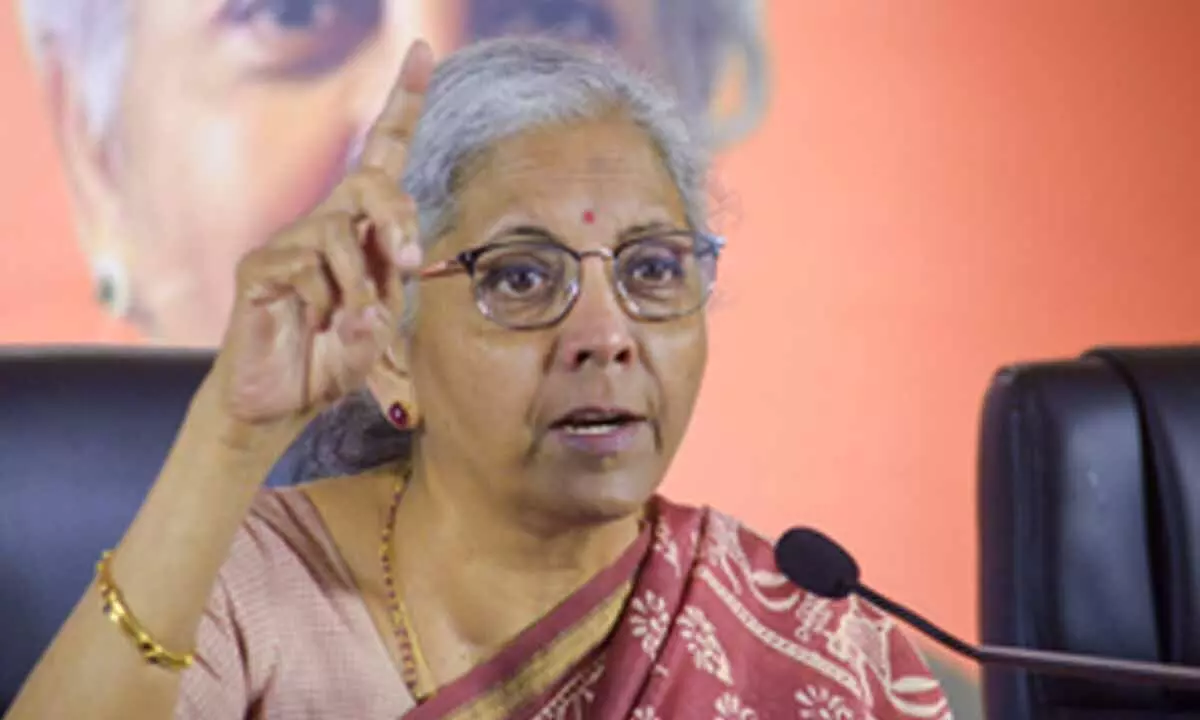Live
- MUDA case: Petitioner claims Lokayukta officers shielding accused
- IPL 2025 Auction: Pant was always in our bucket list, says LSG's Shashwat Goenka
- Andhra Pradesh's Bold New Strategy to Fix Highways Forever
- Asia-Pacific’s EV battery market to reach 29.9 mn units by 2029, India’s FAME makes strides
- Samajwadi Party slams UP govt over Sambhal violence, calls it orchestrated
- BGT 2024-25: Very proud of the way we came back after being put under pressure, says Bumrah
- CBI gets evidence about circulation of expired medicines on RG Kar campus
- Now complaint filed with Governor against Karnataka Minister M.B. Patil
- Ragging Scandal at Khammam Medical College: Professor Faces Action for Shaving Student’s Head
- More Waqf notices issued during BJP's tenure: Karnataka HM on statewide stir plans
Just In
Union Budget reshaped into strategic blueprint for equitable distribution in last 10 years: Sitharaman

Union Finance Minister Nirmala Sitharaman said on Monday that over the last decade, the Narendra Modi government has reshaped the Union budget from a mere record of expenditures to a strategic blueprint for equitable distribution with a vision of transparency, efficiency and effectiveness in governance.
New Delhi: Union Finance Minister Nirmala Sitharaman said on Monday that over the last decade, the Narendra Modi government has reshaped the Union budget from a mere record of expenditures to a strategic blueprint for equitable distribution with a vision of transparency, efficiency and effectiveness in governance.
“We make judicious and efficient use of every rupee collected from our taxpayers and give them a transparent picture of public finances," Sitharaman said in a detailed post on X.
"This starkly contrasts the @INCIndia-led UPA government's repetitive practice of hiding the deficits through off-budget borrowings and issuance of 'Oil Bonds', which somewhat covertly shifted the fiscal burden to future generations. Under UPA, standard fiscal practices were routinely changed to make Budget numbers look favourable," Sitharaman said.
“We will continue to maximise the value and impact of hard-earned taxpayer money, ensuring it is put to the best possible use for the benefit of all," the Finance Minister observed.
She said: “Now, the entire budgetary exercise, including the legislative process, is completed well before the start of the financial year. This has improved administrative efficiency and delivery of schemes as Ministries have the full budget available from the beginning of the financial year – 1 April."
"This has also empowered the state governments, which used to present the Budget before the Centre. States are now able to plan their own budgets better as they are now aware of details of the Centre’s fiscal plan for the upcoming year," she pointed out.
She said that the Union budgets under the Modi government are characterised by fiscal prudence, transparency, and inclusiveness, ensuring investments in social development and infrastructure.
She said that the Union government administers 108 Centrally Sponsored Schemes (CSS) through state and UT governments, with a budget of approximately Rs 5.01 lakh crore for FY 2024-25 and Rs 4.76 lakh crore for FY 2023-24.
The Finance Minister also said that the presentation of a separate Railway Budget was a colonial practice that commenced in 1924. The practice continued more as a convention than for sound administrative reasons. From FY 2017-18, our government merged the Railway Budget with the Union Budget to bring the affairs of the Railways to centre stage and present a holistic and transparent picture of the Union government’s financial position.
She also said that since FY 2017-18, the distinction between Plan and Non-Plan classification in the budget and accounts has been removed, and the emphasis has shifted to the overall financial allocation of schemes with bifurcation on revenue and capital expenditure.
The earlier artificial distinction between Plan and Non-Plan created a distortion in the perception of the two types of allocations. Plan was considered ‘good’ and often referred to as Developmental expenditure, while Non-plan was considered ‘bad’ and wrongly signified ‘non-developmental outlays’.
"This distinction and perception were incorrect as there was reluctance to allocate for ‘non-plan expenditure’, which comprised items such as maintenance of the defence systems, social security-related allocation (pension and insurance), various welfare measures and subsidies for the poor and underprivileged. These couldn’t be termed as 'non-developmental' while allocating resources," she added.

© 2024 Hyderabad Media House Limited/The Hans India. All rights reserved. Powered by hocalwire.com






